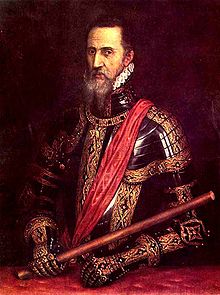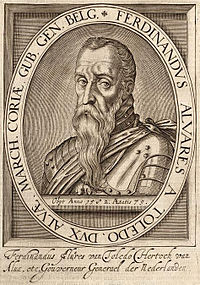- Fernando Álvarez de Toledo, 3rd Duke of Alba
-
Fernando Álvarez de Toledo
Duke of Alba
Governor of the Spanish Netherlands In office
1567–1573Monarch Philip II of Spain Preceded by Margaret of Austria Succeeded by Luis de Requesens Viceroy of Portugal In office
1580–1582Monarch Philip II of Spain Preceded by New title Succeeded by Albert, Archduke of Austria Personal details Born 29 October, 1507
Piedrahíta, Ávila, SpainDied December 11, 1582 (aged 75)
Lisbon, PortugalReligion Catholic Military service Allegiance  Spain
SpainBattles/wars
- Ottoman-Habsburg wars
- Italian Wars
- Siege of Perpignan
- Schmalkaldic War
- Dutch Revolt
- War of the Portuguese Succession
Don Fernando Álvarez de Toledo y Pimentel, 3rd Duke of Alba[1] (29 October 1507 – 11 December 1582) was a Spanish general and governor of the Spanish Netherlands (1567–1573), nicknamed "the Iron Duke" in the Low Countries because of his harsh and cruel rule there and his role in the execution of his political opponents and the massacre of several cities.
Contents
Early life
Alba's grandfather, Fadrique Álvarez de Toledo, educated him in military science and politics; and he was engaged with distinction at the Battle of Pavia in 1525, while still a youth.
Selected for a military command by Charles V, he took part in the siege of Tunis (1535), and successfully defended Perpignan against the dauphin of France. He was present at the Battle of Mühlberg (1547), and the victory gained there over the Prince-Elector Johann Friederich of Saxony was due mainly to his exertions. He took part in the subsequent successful siege of Wittenberg defended by the Electress, Sybille, following which Alba presided at the court-martial which tried the Prince-Elector and condemned him to death as a rebel against the Emperor, wringing from him the Capitulation of Wittenberg (1547), in which he was compelled to resign the electoral dignity and a great part of his territory to his cousin Maurice.
In 1552 Alba was entrusted with the command of the army intended to invade France, and was engaged for several months in an unsuccessful siege of Metz. In consequence of the success of the French arms in Piedmont, he was made commander-in-chief of all the emperor's forces in Italy, and at the same time invested with unlimited power. Success did not, however, attend his first attempts, and after several unfortunate attacks he was obliged to retire into winter quarters.
After the abdication of Charles V he was continued in the command by Philip II, who, however, restrained him from extreme measures. Alba had subdued the whole Campagna and was at the gates of Rome, when he was compelled by Philip's orders to negotiate a peace.
Not long after this (1559) he was sent at the head of a splendid embassy to Paris to espouse, in the name of Philip, Elizabeth, daughter of Henry, king of France. These negotiations led to the Peace of Cateau-Cambrésis.
Netherlands
In 1567, Philip, who was a zealous opponent of Protestantism, sent Alba into the Netherlands at the head of an army of 12,000 men, with unlimited powers for the extirpation of the heretics. Alba quickly erected a tribunal, the Council of Troubles, which soon became known to the Calvinists as the "Council of Blood," to try all persons who had been engaged in the late commotions that the rule of Philip had excited. During the ten years it operated, thousands of people were executed. The precise number is disputed: Dutch sources cite 18,000 victims, while Spanish accounts mention only a few hundred. About 12,000 casualties can be considered as the most accurate estimate, of which 1,083 were executed.[2] Alba imprisoned the Count of Egmont and the Count of Hoorn, the two popular leaders of the dissatisfied Dutch nobles, and had them condemned to death even though they were Catholics.
Alba attempted to raise money by imposing the Spanish alcabala, a tax of 10% on all sales ("tenth penny" tax) on the Low Countries, and this aroused the opposition of many Catholic residents as well. The exiles from the Low Countries, who called themselves Geuzen (French gueux, "beggars"), encouraged by the general resistance to his government, fitted out a fleet of privateers, and after strengthening themselves by successful depredations, seized the town of Den Briel (Brielle). Thus Alba, by his unrelenting harshness, became the unwitting instrument of the future independence of the seven Dutch provinces.
On August 22, Alba, accompanied by a body of select Spanish troops, made his entry into Brussels. He immediately appointed a council to condemn without trial those suspected of heresy and rebellion. On June 1, 1568, Brussels witnessed the simultaneous decapitation of twenty-two noblemen; on 6 June followed the execution of the Counts of Egmond and Hoorne.[citation needed]
The fleet of the exiles, having met the Spanish fleet, defeated it and reduced Holland and Mons. The States of Holland, assembling at Dordrecht in 1572, openly declared against Alba's government, and marshaled under the banners of the prince of Orange.[citation needed]
Alba's preparations to defeat the gathering storm were made with his usual rapidity and vigour, and he succeeded in recovering Mons, Mechelen and Zutphen, under the conduct of his son Don Fadrique. All three cities were sacked and many civilians killed. With the exception of Zeeland and Holland, he regained all the provinces; and at last his son stormed Naarden, massacring every man, woman and child,[3] proceeded to invest the city of Haarlem, which, after standing an obstinate siege, was taken and pillaged. Their next attack was upon Alkmaar; but there they were met with such desperate resistance that Alba was forced to retire.[citation needed]
Retirement and disgrace
Alba's feeble health and continued lack of success induced him to solicit his recall from the government of the Low Countries. In December 1573 Philip accepted his resignation and replaced him with Luis de Zúñiga y Requesens.
On his return he was treated for some time with great distinction by Philip. But then his son, Fadrique de Toledo, secretly wed the daughter of García de Toledo, against the king’s orders. The affair dragged both father and son into disgrace. Alba was banished from court and retired to the castle of Uceda.
Alba remained in exile at his castle up to 1580, when his leadership was sought again in the war against Portugal.
In Portugal
Alba remained in exile two years, when the success of António, Prior of Crato, in assuming the crown of Portugal caused Philip to turn to Alba as the man whose ability and fidelity he could most rely on. Made supreme commander in Portugal in 1580, Alba soon defeated António in the Battle of Alcântara, drove him from the kingdom, and reduced Portugal to the subjection of Philip. Entering Lisbon he seized an immense treasure, and allowed his soldiers to sack the suburbs and vicinity. Alba, however, did not enjoy the honors and rewards of his last expedition, for he died at Lisbon on December 11, 1582.
Descendants
In 1527, the Duke married his cousin María Enríquez de Toledo y Guzmán, daughter of Diego Enríquez de Guzmán, 3rd Count of Alba de Liste, with whom he had four children.
By María Enríquez de Toledo:
- García Álvarez de Toledo (1530–1548).
- Fadrique Álvarez de Toledo, 4th Duke of Alba (1537–1583).
- Diego Álvarez de Toledo (?–1583), Count of Lerin, married Briande de Beaumont (1540–1588).
-
- Antonio Álvarez de Toledo y Beaumont, 5th Duke of Alba.
- Beatriz Álvarez de Toledo, married Álvaro Pérez de Osorio, 5th Marquis of Astorga.
Illegitimate:
- Fernando de Toledo (1527–1591), recognized in 1546, Viceroy of Catalonia.
Ancestry
8. García Álvarez de Toledo
1st Duke of Alba4. Fadrique Álvarez de Toledo
2nd Duke of Alba9. María Enriquez 2. García de Toledo 10. Álvaro de Zuñiga
Duke of Plasencia5. Isabel de Zúñiga y Pimentel 11. Leonor de Pimentel 1. Fernando Álvarez de Toledo 12. Alonso Pimentel Enríquez
Count of Benavente6. Rodrigo Alonso Pimentel
Duke of Benavente13. María de Quiñones 3. Beatriz Pimentel 14. Juan Pacheco, 1st Duke of Escalona 7. María Pacheco
Lady of Villacidaler15. María Portocarrero Additional information
Notes
- ^ In full, Spanish: Don Fernando Álvarez de Toledo y Pimentel, tercer Duque de Alba de Tormes, tercer marqués de Coria, conde de Piedrahita, señor del estado de Valdecorneja, señor del estado de Huéscar, caballero del Toisón de Oro, capitán general de los Reales Ejércitos, consejero de Estado, Mayordomo mayor del rey, Virrey, gobernador y capitán general de Nápoles, gobernador de los Paises Bajos
- ^ Israel, Jonathan I. (1995). The Dutch Republic: Its Rise, Greatness, and Fall 1477–1806. Oxford, UK: Clarendon Press. pp. 159–160. ISBN 0198730721.
- ^ Israel, p. 178.
Sources
 This article incorporates text from a publication now in the public domain: Chisholm, Hugh, ed (1911). Encyclopædia Britannica (11th ed.). Cambridge University Press. article is available here
This article incorporates text from a publication now in the public domain: Chisholm, Hugh, ed (1911). Encyclopædia Britannica (11th ed.). Cambridge University Press. article is available here- Hobbs, Nicolas (2007). "Grandes de España" (in Spanish). http://grandesp.org.uk/historia/titulos/titintro.htm. Retrieved 15 October 2008.
- Instituto de Salazar y Castro (in Spanish). Elenco de Grandezas y Titulos Nobiliarios Españoles. periodic publication
Government offices Preceded by
Ferdinando GonzagaGovernor of the Duchy of Milan
1555–1556Succeeded by
Cardinal Cristoforo MadruzzoPreceded by
Margaret of AustriaGovernor of the Habsburg Netherlands
1567–1573Succeeded by
Luis de ZúñigaNew title Viceroy of Portugal
1580–1582Succeeded by
Cardinal Albert Archduke of AustriaSpanish nobility Preceded by
Fadrique Álvarez de ToledoDuke of Alba
1531–1582Succeeded by
Fadrique Álvarez de ToledoCategories:- 1507 births
- 1582 deaths
- Governors of the Habsburg Netherlands
- Viceroys of Naples
- Viceroys of Portugal
- Viceroys of Catalonia
- Spanish generals
- Spanish politicians
- Spanish nobility
- Spanish Roman Catholics
- Dukes of Alba
- House of Alba
- Álvarez de Toledo family
- Knights of the Golden Fleece
- 16th-century Spanish people
- Spanish people of the Eighty Years' War
- Anti-Protestantism
- Protestant-related controversies
- Eighty Years' War
Wikimedia Foundation. 2010.



